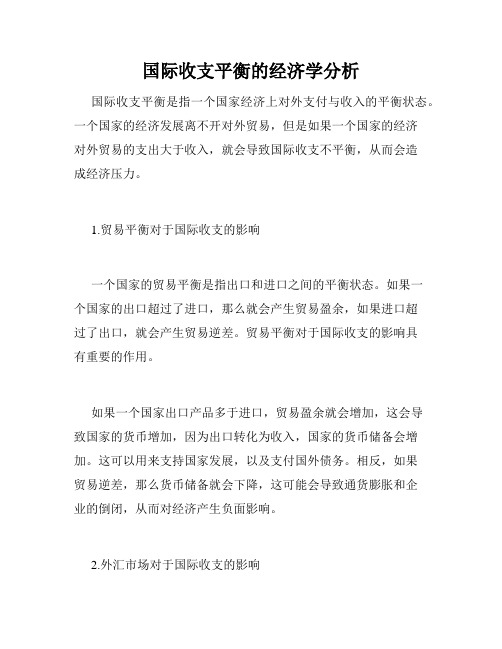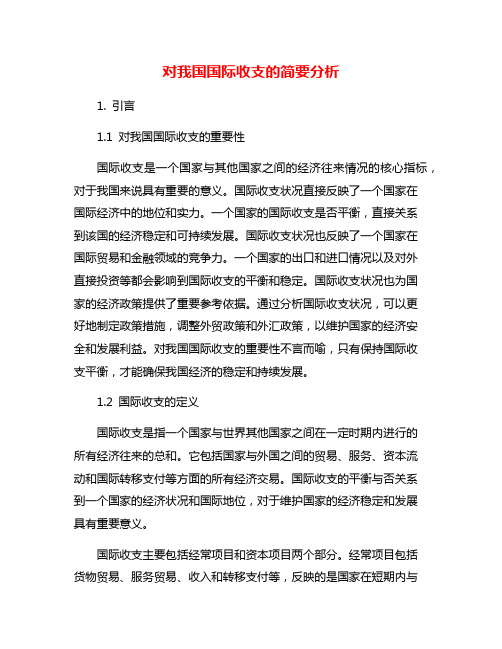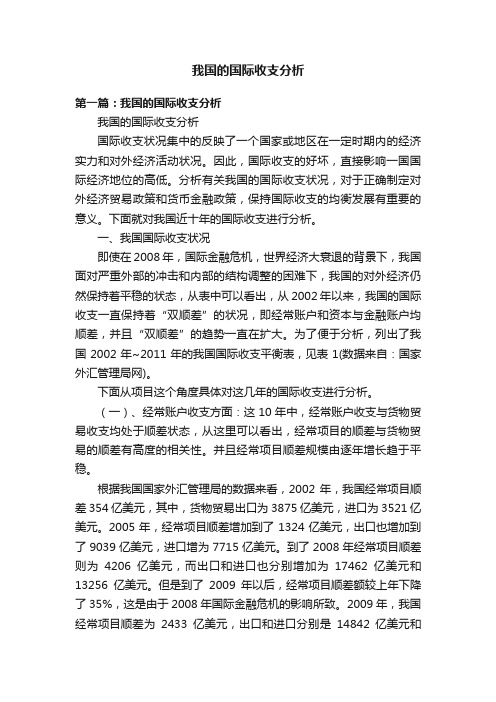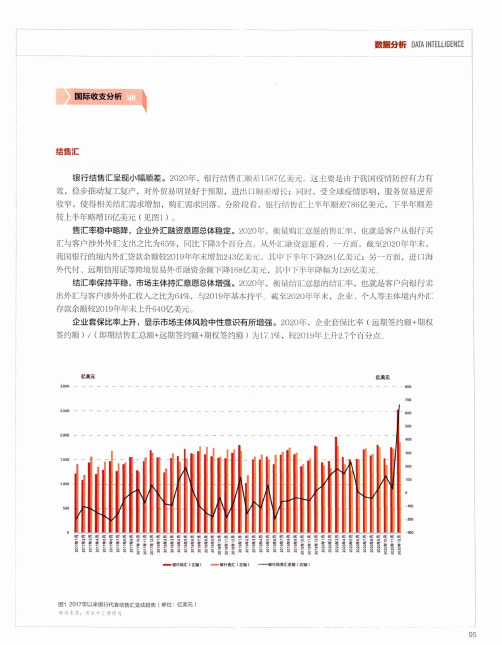第十章 国际收支分析
对我国国际收支的简要分析

对我国国际收支的简要分析我国国际收支是指中国与其他国家之间的经济往来所产生的资金流动情况。
国际收支是一个国家经济和贸易活动的重要指标,也是国家经济发展和对外开放程度的重要反映。
对我国国际收支进行简要分析,有助于了解我国在国际经济领域的地位和挑战,为相关政策制定提供参考。
从国际收支的结构来看,我国主要的国际收入包括出口贸易收入、服务贸易收入、外商直接投资收入和对外援助收入等。
而国际支出则主要包括进口贸易支出、服务贸易支出、对外投资支出和对外援助支出等。
这些资金流动的结构反映了我国与其他国家的经济交流和合作情况。
从国际收支的总体情况来看,我国国际收支一直处于顺差状态。
这主要是由于我国作为世界第二大经济体和全球最大出口国,出口贸易收入一直维持较高水平。
随着经济发展和对外开放的不断深化,外商直接投资收入也逐渐增加,为我国国际收支顺差提供了有力支持。
从国际收支的影响因素来看,我国国际收支的变化受到多种因素的影响。
首先是国际市场需求和价格波动的影响,特别是主要出口产品的市场需求和价格波动对我国出口贸易收入产生直接影响。
其次是国际金融市场的波动,包括国际汇率的波动和外部资本流动对我国国际收支产生间接影响。
国际政治和地缘经济格局的变化,如贸易摩擦、对外关系紧张等因素也可能对我国国际收支带来一定影响。
从国际收支的政策应对来看,我国已经采取了一系列措施来应对国际收支的挑战。
一方面,我国积极推动贸易自由化和便利化,加强与其他国家的贸易合作,扩大出口市场,提升国际竞争力。
我国加强对外投资管理和风险防范,谨慎对外援助,保障国际收支的平衡和稳定。
我国国际收支是一个复杂的系统工程,受多种因素的影响,需要全面分析和精准应对。
通过对我国国际收支的简要分析,我们可以清晰地认识到我国在国际经济领域的地位和挑战,为相关政策制定提供参考,进一步促进我国国际收支的平衡和稳定。
第十章 国际收支失衡调节

第三节 国际收支的吸收分析
一、基本原理
Y C I G (X M)
B X M Y (C I G) Y A
A A0 aY
dB (1 a)dY dA0
dY——贬值对收入的直接影响; a ——贬值通过收入变化对吸收的间接影响; dA0——贬值的直接吸收效应。
二、贬值的收入效应和吸收效应 (一)贬值的收入效应 1.闲置资源效应。国际收支最终是得到改善还是恶化, 取决于边际吸收倾向。假定自主吸收不变(dA0=0), 只要边际吸收倾向a<1,贬值所引起的国民收入增加 (dY)就会大于国民收入增加所导致的吸收的增加 (adY),国际收支就能得到改善(dB>0)。
——John Maynard Keynes
第一节 价格—铸币流动机制
金本位制下的自动调节 ——“价格-铸币”流动机制
“价格-铸币”流动机制
1752年英国著名的 古典经济学家大卫. 休莫提出了著名的 “价格-铸币”流 动机制。该机制阐 述了在金本位制下 国际收支失衡的自 动调节功能。
David Hume, 1711-1776
第二节 国际收支的吸收分析
三、吸收分析理论的政策含义
改善国际收支就只能改变国民收入或改变国内吸收或同时 改变二者,即所谓的支出增减政策(expenditure-changing policies)和支出转换政策(expenditure-switching policies)。 支出增减政策主要通过支出水平的变动来调节社会需求的 总水平,包括财政政策与货币政策;
在上述三个条件下,一国的货币供给直接与国际收支挂钩, 国际收支盈余的国家将有黄金流入,导致货币供给量增加; 国际收支赤字的国家将有黄金流出,导致货币供给量减少。
(2)国际金本位制下的国际收支自动调节机制
对我国国际收支的简要分析

对我国国际收支的简要分析我国国际收支是指我国与外国之间的经济交流和货物、服务、资本等的进出口情况。
国际收支对我国经济发展起着重要的影响,因此对其进行简要的分析是十分必要的。
从货物贸易方面来看,我国的出口额持续增长,显示出我国在全球经济中的地位不断提升。
中国是世界最大的商品生产和出口国,出口额占GDP的比重逐年攀升。
中国制造的商品以其价格竞争力和质量优势在国际市场上保持竞争力。
我国也日益依赖进口,尤其是能源和高端技术产品的进口需求不断增加。
这意味着我国国际收支的平衡性受到了一定的压力。
从服务贸易方面来看,我国的服务出口也在逐渐增加。
旅游、教育、医疗等服务行业的国际合作越来越频繁,中国的服务贸易逆差有所减小。
与此我国也加大了服务业的对外开放力度,吸引了更多的国际服务项目和企业来华投资。
这一方面促进了我国服务出口的增长,另一方面也提高了我国居民的消费水平和生活质量。
从资本项目方面来看,我国吸引外国直接投资(FDI)的能力不断增强。
由于我国巨大的市场规模和潜力,以及政府推行的一系列对外开放政策,外国投资者对中国市场的兴趣持续高涨。
我国也积极推动中国企业“走出去”,扩大对外投资规模。
这些都有助于提高我国国际收支的平衡性。
从金融流动方面来看,我国国际收支的形势相对复杂。
一方面,我国逐渐推动人民币国际化,加强与国际金融市场的联系,促进人民币资产进出口的顺利进行。
与此我国也积极参与国际金融合作和机构建设,提高我国在全球金融体系中的地位。
我国面临资本外流的风险,在金融市场的变动和冲击下,我国的国际收支也面临一定的不确定性。
我国国际收支的形势总体上是积极向好的,但也存在着一些挑战和风险。
在全球化背景下,我国应继续加大对外开放力度,扩大出口和服务出口,提高国际市场的份额和竞争力。
也要积极引进外商投资,推动中国企业走向世界。
在金融方面,我国需要加强监管和风控,保持金融体系的稳定和健康发展。
只有如此,我国国际收支才能更好地为经济社会发展作出贡献。
对我国国际收支的简要分析

对我国国际收支的简要分析我国国际收支是指我国与其他国家和地区之间的经济往来和资金流动的总体表现。
通过分析我国国际收支的情况可以了解到我国经济发展的整体水平和国际竞争力。
以下是对我国国际收支的简要分析。
我国国际收支的总体状况呈现逆差状态。
这意味着我国对外净支付,需通过贸易顺差、资本净流出等方式来弥补对外支付。
近几年,我国国际收支逆差规模有所扩大,主要原因是我国出口增速放缓,而进口增速保持相对较快的增长,导致贸易顺差缩小。
资本净流出也在增加,部分资金流向了境外市场和企业。
我国国际收支结构呈现出特点明显的贸易逆差和服务贸易顺差。
贸易逆差主要由商品贸易逆差引起,而服务贸易顺差主要来自于旅游服务、咨询服务、技术服务等领域。
贸易逆差主要是由于我国在劳动密集型和能源资源型产品方面具有一定的竞争优势,导致大量的进口需求。
而服务贸易顺差则是由于我国在服务领域的国际竞争力不断提升,吸引了大量的外国游客和外资投资。
我国国际收支在结构上呈现出有限的多元化。
我国主要的国际收支来源包括贸易、投资、劳务等方面。
贸易是我国国际收支的主要来源,约占总体的大部分。
近年来我国国际收支来源的多元化程度有所提高,特别是在投资方面。
我国对外直接投资成为我国国际收支的重要组成部分,同时也吸引了大量的外资进入我国市场。
第四,我国国际收支存在一些风险和挑战。
全球贸易保护主义的抬头可能导致我国对外贸易面临一定的压力。
我国经济结构的调整和转型也会对国际收支产生一定的影响。
特别是我国正在加快推进创新驱动和高质量发展,这对于提升我国在服务贸易和技术交流方面的竞争力具有重要意义。
我国国际收支呈现出逆差态势,同时贸易逆差和服务贸易顺差结构明显。
我国国际收支也面临一定的风险和挑战。
需要进一步推进经济结构优化和转型升级,加强国际竞争力,以实现国际收支的平衡和可持续发展。
《国际收支分析精》课件

国际收支平衡的分类
国际收支平衡可分为贸易平衡、资本平衡和总体收支平衡。
3
国际收支平衡的调节方式
国际收支不平衡可通过货币汇率调节、贸易政策调整以及资本流动管制等方式进行调节。
三、国际收支不平衡分析
国际收支不平衡的原因
国际收支不平衡的原因包括贸易 逆差、资本流动不平衡以及经济 结构失衡。
国际收支不平衡的表现
国际收支与可持续发展之间存在着相互影响和相互制约的关系,需要寻求平衡点。
3
国际收支对全球经济变化的应对策略
国际收支的变化需要通过宏观政策调整、国际合作以及结构性改革等策略来应对。
结语
1 总体回顾
我们通过本课件对国际收 支的概念、平衡与不平衡 分析以及与汇率的关系等 进行了系统介绍。
2 未来展望
我们希望通过对国际收支 的深入研究,为经济发展 和国际经济关系的良好发 展做出更多贡献。
国际收支不平衡的表现包括贸易 逆差、外汇储备下降以及经济增 长放缓等。
国际收支不平衡的解决方法
国际收支不平衡可通过促进出口、 加强资本流动监管以及实施结构 性改革等方式进行解决。
四、国际收支与汇率
汇率的含义
汇率是一种国家货币与其他 国家货币交换比率的表示, 决定着国际收支的平衡与不 平衡。
汇率的种类
汇率种类包括实际汇率、名 义汇率以及有效汇率,不同 种类反映了不同的经济因素。
汇率的决定因素
汇率的决定因素包括利率、 通胀率、国际投资者对国家 的信心以及政府干预等。
五、国际收支与经济发展
1
国际收支对经济发展的影响
国际收支的平衡和稳定有助于促进经济增长、改善就业状况以及提高国家的国际 竞争力。
国际收支平衡的经济学分析

国际收支平衡的经济学分析国际收支平衡是指一个国家经济上对外支付与收入的平衡状态。
一个国家的经济发展离不开对外贸易,但是如果一个国家的经济对外贸易的支出大于收入,就会导致国际收支不平衡,从而会造成经济压力。
1.贸易平衡对于国际收支的影响一个国家的贸易平衡是指出口和进口之间的平衡状态。
如果一个国家的出口超过了进口,那么就会产生贸易盈余,如果进口超过了出口,就会产生贸易逆差。
贸易平衡对于国际收支的影响具有重要的作用。
如果一个国家出口产品多于进口,贸易盈余就会增加,这会导致国家的货币增加,因为出口转化为收入,国家的货币储备会增加。
这可以用来支持国家发展,以及支付国外债务。
相反,如果贸易逆差,那么货币储备就会下降,这可能会导致通货膨胀和企业的倒闭,从而对经济产生负面影响。
2.外汇市场对于国际收支的影响外汇市场是指一个国家的货币与其他国家货币交换的市场。
外汇市场对于国际收支也具有重要作用。
如果一国货币流出更多,那么就需要更多的外汇来支付贸易逆差。
如果国家没有足够的外汇,这就会导致货币贬值,因为需求大于供应。
货币贬值对于国际收支会产生积极影响,因为贸易逆差会随着货币贬值而减少,这同时也会刺激出口增长,从而增加收入。
因此,货币贬值与贸易逆差之间存在着紧密联系。
3.对外投资和对外援助对于国际收支的影响对外投资和对外援助对于国际收支也具有积极的影响。
对外投资可以刺激外国的就业和消费,从而增加对本国产品的需求。
这可以促进贸易平衡,从而对于国际收支的平衡产生积极的影响。
此外,对外投资还可以刺激国内经济的发展,从而改善外汇储备和经济增长。
对外援助可以促进经济发展,从而刺激进口增长,从而创造出口机会。
此外,援助还可以创造就业机会和提高人民的生活水平,从而产生积极的经济效应。
4.结论综上所述,国际收支平衡对于一个国家的经济发展至关重要。
经济的发展离不开对外贸易,外汇市场和对外援助等多个因素的综合影响。
因此,发展国际贸易和吸引对外投资,增加外汇储备,提高出口质量和创造就业机会,都可以对于国际收支平衡产生积极的影响。
国际收支分析

二、调整国际收支失衡的主要政策
(一)支出调整政策
(1)财政政策
(2)货币政策 (二)外汇缓冲政策
(三)汇率政策
(四)直接管制 (五)国际经济金融合作政策
第三节
国际收支的弹性分析
一、弹性分析的基本思想 二、马歇尔—勒纳条件 三、弹性分析法的局限性
一、弹性分析的基本思想
国际收支分析
教学目的与要求
了解局部平衡和总体平衡的含义
熟悉国际收支失衡的类型、原因与调节措施 把握国际收支与宏观经济的关系 掌握国际收支分析的基本方法。
主要教学内容
(1)国际收支的平衡与失衡、国际收支失衡类型及
其产生成因、国际收支失衡的影响、国际收支调节的 政策措施。 (2)国际收支理论及分析方法,如弹性分析、吸收 分析、货币分析。
而忽视了汇率变化对社会总支出和总收入的影响,只 考虑了汇率变动的替代效应而忽略了收入效应,且供 给弹性为无穷大与充分就业假定有逻辑上的矛盾。 (2)忽略了资本流动,实际上,汇率变动对资本账户 有重要影响。 (3)弹性分析只是一种比较静态分析,实际上,贬值 与贸易数量的变动存在时滞。 (4)弹性理论分析了货币贬值后初始阶段的价格,而 没有考察继发的通货膨胀。 (5)弹性分析的局部均衡方法“其他条件不变”的假 定是不合乎实际的。通货膨胀、国民收入、利率等都 在变化。
(二)简单的弹性分析
(二)简单的弹性分析
一般认为,弹性绝对值>1代表有弹性,弹性绝对
值<1则是无弹性。
汇率的高低决定并反映着一国产品与外国产品之间
的相对价格,即国内外贸易商品的相对价格发生变 化,国际收支也随之发生变化。
三、弹性分析法的局限性
弹性分析法的主要缺陷与其局部均衡分析有关: (1)仅局限于分析汇率变化对货物进出口市场的影响,
对我国国际收支的简要分析

对我国国际收支的简要分析1. 引言1.1 介绍国际收支的概念和重要性国际收支是指一个国家或地区与其他国家或地区之间在一定时期内的经济往来,包括货物、服务、资金和技术等各种交易。
国际收支是国际经济关系的重要组成部分,对一个国家的经济发展和稳定具有重要的影响。
国际收支的平衡与否直接影响着一个国家经济的稳定性和可持续发展。
一个国家的国际收支出现逆差时,可能导致外汇储备的下降,进而影响到国家的汇率和金融稳定。
而国际收支的顺差则能够增加国家的外汇储备,提升国家的国际信用和经济实力。
国际收支不仅反映了一个国家的经济实力和竞争力,也是国家对外开放程度和国际地位的重要表现。
通过对国际收支的分析,可以了解一个国家在国际经济中的定位和竞争优势,为政府制定宏观经济政策和调控国民经济提供重要依据。
对我国国际收支的研究和分析具有重要的理论和现实意义。
2. 正文2.1 我国国际收支的总体情况我国国际收支的总体情况主要包括当前的收支状况、收支的变化趋势以及主要影响因素等方面。
近年来,我国国际收支总体呈现出逐渐增加的趋势,主要得益于我国外贸的持续增长和外资流入的增加。
我国在国际贸易中的地位不断提升,出口和进口逐年增加,贸易顺差逐渐扩大。
外资的流入也在增加,包括外商直接投资和证券投资等形式。
这些外资的流入为我国带来了资金和技术等方面的支持,促进了经济的发展。
我国国际收支也存在一些问题,如贸易顺差过大、外资流入的不稳定性、外汇储备管理不够精细等。
这些问题可能会对我国的经济稳定和可持续发展产生一定的影响。
需要政府加强管理,采取有效的政策措施,促进国际收支的平衡和稳定发展。
我国还应该积极拓展国际市场,多元化外资来源,加强外汇储备管理,提高我国国际收支的抗风险能力。
通过这些努力,我国国际收支将更加稳定,为经济发展提供更强有力的支持。
2.2 外贸对我国国际收支的影响外贸对我国国际收支的影响是非常重要的。
外贸是我国国际收支的重要组成部分,对于出口和进口的规模和结构,直接影响着我国的国际收支平衡。
对我国国际收支的简要分析

对我国国际收支的简要分析我国国际收支是指我国与世界各国在经济交往中所形成的国际收支关系。
它是指在一定时期内,包括出口收入、进口支出、服务收入、服务支出、资本收支等各项国际支付项目在外币计价条件下的总体收支状况。
国际收支状况反映了一个国家的对外经济活动的规模、结构、发展趋势以及国际经济地位和国际竞争力。
我国国际收支的总体情况呈现出一定的特点。
近年来,我国国际收支总体保持了较好的平衡状态。
我国国际收支逐渐呈现出逐渐向好的趋势,年度收支逐渐呈现顺差状态,这与我国经济实力的提升密不可分。
特别是近年来,我国国际收支顺差规模不断扩大,逐渐成为世界上规模最大的国际收支顺差国家之一。
这一方面表明我国外贸发展取得了显著成就,另一方面也突显了我国国际竞争力的不断增强。
值得一提的是,我国对外直接投资和境外投资的规模逐年扩大,也是我国国际收支逐渐向好的重要原因之一。
我国国际收支的结构呈现出一定的特点。
我国国际收支的结构不断优化升级,贸易结构逐步优化,服务贸易增长势头明显。
在商品贸易领域,我国在国际市场上具有一定的竞争优势,以制造业、劳动密集型产品为主的出口依然是我国国际收支的主要支撑,但技术密集型产品和服务贸易的比重不断提升。
在服务贸易方面,我国正在加快布局服务出口,服务贸易呈现快速增长的态势,尤其是信息技术和文化创意产业,具有较大的发展潜力。
我国境外投资增速显著,我国对外直接投资的结构逐渐改善,从以前的资源型投资扩展到具有科技含量和附加值高的制造业和服务业,同时也加快了对外资本市场的开放,境外投资的覆盖面和规模都逐渐扩大。
我国国际收支的挑战和问题也是明显存在的。
尽管我国国际收支总体上保持顺差,但在一些方面仍然存在着一些问题和挑战。
在外贸方面,我国出口面临国际市场需求不足、国际贸易摩擦和保护主义倾向增加等不利影响因素,这给我国商品出口带来了一定的压力。
我国对外贸易也存在着结构单一、附加值偏低等问题,制约着我国出口的竞争力和盈利水平。
国际收支的分析

国际收支的分析
一、国际收支的平衡、顺差和逆差
(一)国际收支的自主性交易和补偿性交易
国际收支平衡表中所记录的各种经济活动具有两 种不同性质,一种是自主性交易(autonomous transaction),或事前交易(ex-ante transaction),由交易人出于商业利润动机或其 他方面的考虑而独立发生的交易;另一种交易是 补偿性交易或调节性交易。换句话说,补偿性交 易并不因为其本身而存在,而是因为其他交易即 自主性交易而产生,本质上是一种弥补自主性交 易失衡的融通性交易。
如果一国国际收支连年出现逆差,就会使该国的 官方储备不足,国际清偿能力下降。那么,该国 将被迫压缩进口,从而影响经济的发展,对于发 展中国家来说,连年逆差不利于引进国外先进的 技术和设备
4
2022年12月14日
如果一国国际收支连年出现逆差,如果依靠借 款来弥补逆差,那将很容易陷入债务危机。
发展中国家为促进本国经济发展,大量举债以 应付进口,最后债台高筑,反而阻碍了经济发 展,此等例子并不少见。
5
2022年12月14日
而国际收支的大量顺差将使国内货币供应量增 加;如果顺差主要是由于贸易顺差所引起,那 么国内市场的商品供应将减少,从而加重通货 膨胀的压力。
一国国际收支特别是贸易收支长期拥有大量顺 差,容易引发与相关国家的贸易摩擦,有可能 遭到它们的报复。近些年来,连续出现的中、 美,中、日贸易摩擦就是一例。
6
2022年12月14日
四、国际收支失衡的调节措施 (一)国际收支失衡的自动调节机制 1.金本位制下的自动调节机制 2.浮动汇率制下的自动调节机制 (二)国际收支失衡的政策调节措施 1.货币政策 2.财政政策 3.外汇政策 4.直接管制和关税政策
对我国国际收支的简要分析

对我国国际收支的简要分析我国国际收支是指国家与外部世界之间的经济往来所形成的一种经济现象,是国际经济关系中的一项重要内容。
国际收支表是反映一个国家一定时期内国际经济交易活动的统计报表,并且是国际经济关系的一个总和体现。
它反映了一个国家在国际经济往来方面的真实情况,是国际收支状况的指标。
国际收支分为收入项目和支出项目。
收入项目包括出口货物和服务、投资收益、移民与非移民转移收益等;支出项目包括进口货物和服务、投资支出、移民与非移民转移支出等。
国际收支平衡是指收入项目和支出项目保持平衡的状态,而国际收支逆差则是指支出项目大于收入项目,导致国际收支不平衡。
国际收支的平衡与否,代表了一个国家的经济健康及其与外国经济关系的发展水平。
我国国际收支在过去几年一直处于逆差状态,主要原因是我国在世界分工中处于较低端,从事的是劳动密集型产业,产品附加值低、利润空间窄,导致国际贸易逆差比较大。
我国对外直接投资也不断增加,国际收支逆差不断扩大。
我国因为人民币升值,出口竞争力下降,也是导致国际收支逆差的重要原因之一。
这些问题使我国国际收支一直处于逆差状态。
但是近年来,我国国际收支出现了一些积极的变化。
我国的进口和出口额不断增加,特别是出口额的增长比例更为显著。
这主要是因为中国不断提高对外开放水平,着力于扩大外贸出口,并加大了进口商品的自主产权。
我国的服务贸易逐渐增加,尤其是知识产权、文化与旅游等服务贸易增速迅猛,为国际收支的改善作出了积极的贡献。
我国的对外投资额同样不断增加,虽然存在一定的逆差,但是总体来说对国际收支有所促进。
我国的人民币汇率也基本稳定,比较均衡,这有助于我国的出口和进口,为国际收支的平衡起到了一定帮助。
需要指出的是,我国国际收支的改变还存在一些问题。
我国在国际收支中服务贸易的比重还相对较小,尤其是文化、教育等软实力出口不足,需要进一步提升。
我国在国际收支中的外商投资收益较低,需要加大对外投资的高端产业和高科技产业的投资力度。
国际收支分析

银行结汇(左轴)■银行售汇(左轴)-银行结售汇差额(右轴)■1 2016年以来银行代客结售汇变动趋势(单位:亿美元)教掘来源:肉汴r t 楗场数据分析 DATAINTEUIGENCE国际收支分析结售汇11月份我国外汇市场运行稳健,市场主体结汇和售汇交易趋于自主平衡。
2020年11月,银行结售汇顺差30亿美元,较上月更趋平衡。
市场主体结售汇意愿总体平稳,衡量企业结汇意愿的结汇率,也就是客户向银行卖出外汇与客户涉外外汇收 入之比为63%,与上年同期基本持平;衡量购汇意愿的售汇率,也就是客户从银行买汇与客户涉外外汇支出之比为65%,同 比略降1个百分点。
主要渠道收/结汇和跨境资金流动有增有减、合理分化。
2020年11月,在海关进出口顺差增长的带动下,货物贸易结售汇顺差同比增加55亿美元;服务贸易结售汇逆差同比收窄56亿美元,继续保持低位。
跨境双向直接投资保持活跃,资金净流 入规模与上年同期基本持平;股票项下双向投资基本稳定,其中“陆股通”渠道外资净买入A 股579亿元人民币,“港股通” 渠道居民净买入H 股601亿元人民币。
当前,外汇市场运行平稳有序,跨境资金流动双向均衡;但鉴于新冠肺炎疫情发展和外部环境仍存在诸多不确定性,金 融机构和企业要树立“风险中性”意识,管理好经营风险。
亿美元亿美元2,500300200100-100-200-300-400-500y i L掛 os (Nm:64j -os f Ny ^i i f o s C NIn:Ln 肿 o s r N Im:ro 掛 o s (N In:L 掛 o s (Nm:u ^6L 03m:6 壯 6L O O Iy v壯 6L 0C N m:s 壯6L S叹昼受t n :L 掛 6L0C Nl n :u 掛 8L 0(N t n :6^8L 0{N 驻t oC N In:ln ^8L 0CN I n :發 l o (ny H掛8L 0(>I叹 U掛Z T —O OJln:6 掛Z L O rN胂Z L OfN ys ^Z L OCN yro 掛z l ocntlc L掛z lo cn tn:u 掛9L 0C N I 111:6 掛9L 0CN 肿 9L 0C NI n rL n 掛 9L 0C Ny r o 掛 9L 0C N y i肿 9L 0C N77外汇收支总额—人民币收支总额------外汇收支差额(右轴)—人民币收支差额(右轴)图3 2016年1月一2020年11月银行代客涉外收付款币种情况数据来源+国家外汇管理局涉外收支非银行部门涉外收支基本平衡。
国际收支的平衡问题分析

国际收支的平衡问题分析随着全球化的推进,各国之间的经济联系也越来越紧密。
这就需要各个国家来考虑自己的国际收支问题,以保持经济的稳定和长期可持续发展。
在本文中,我们将对国际收支的平衡问题进行分析,探讨其背后的原因和解决办法。
一、国际收支的概念和作用国际收支是指一个国家在一定时期内,其经济和金融交往中所发生的收入和支出的总和。
其包括贸易收支、资本收支和储备资产变动三个方面。
其中,贸易收支是指一国进出口货物和服务的收支,是国际收支中最重要的方面。
国际收支对一个国家的经济发展非常重要。
一个国家的国际收支状况良好,能够为国家带来许多经济利益。
例如,良好的国际收支可以引进外资,推动国内经济的增长;可以为国家提供一定的外汇储备,保护国家免受国际金融市场波动的影响;还可以促进国际国内市场的繁荣,提高人民生活水平。
二、国际收支不平衡的原因1.国内经济环境不良如果一个国家的内部经济环境不良,会使本国出口的商品失去竞争力,同时还会导致进口商品价格上涨。
这样一来,商品贸易收支不平衡就很容易出现。
2.全球经济不稳定世界经济的波动会对一个国家的国际收支产生影响。
如果全球经济处于衰退期,需求萎缩,贸易额减少,这会导致一个国家的出口额减少,贸易收支不平衡。
3.外汇市场波动外汇市场波动也可能导致一个国家的外汇储备变化,从而影响国际收支的平衡。
如果外汇市场汇率剧烈波动,会给某些国家造成较大的压力,这时需要采取相应的调节措施。
三、如何解决国际收支不平衡问题1.改善国内经济环境国际收支不平衡的主要原因之一是国内经济环境不良。
因此,改善内部经济环境,提高本国商品的质量和竞争力,有助于增加贸易收支的平衡。
2.增加出口和减少进口如果一个国家的出口比进口多,贸易收支就会呈现盈余状态,反之则出现赤字。
因此,可以通过扩大出口和控制进口的数量和质量,从而改善国际收支的平衡。
3.调整汇率如果一个国家的汇率过高或过低,会对贸易收支产生影响。
如果汇率偏高,会使该国的出口商品在国际市场上价格偏高,从而导致出口下降;反之,如果汇率偏低,会使该国的进口商品在国内市场上价格偏低,引起进口增加。
国际收支分析课件

中国国际收支调节政策与实践
总结词
外汇管理、财政政策、货币政策
详细描述
中国国际收支调节政策主要包括外汇管理、财政政策和 货币政策等。外汇管理政策通过调节汇率波动、加强跨 境资金流动监管等措施来平衡国际收支。财政政策通过 调整关税、进口环节税等措施来影响贸易收支。货币政 策通过利率、汇率等工具来调节资本流动和投资收益等。 这些政策相互配合,共同维护国际收支平衡和金融稳定。
2023
PART 04
国际收支理 论
REPORTING
弹性分析法
总结词
详细描述
总结词
详细描述
该理论主要关注汇率变动对贸 易余额的影响。
弹性分析法认为,汇率的变动 会影响一个国家的出口商品价 格和进口商品价格,进而影响 出口额和进口额,最终影响国 际收支。
该理论认为,汇率的贬值可以 改善贸易余额。
总结词
经济全球化、国际产业分工、资本流动
详细描述
中国国际收支失衡的原因主要包括经济全球化背景下国际产业分工的变化、资本流动的 冲击等。国际产业分工的变化使得中国在国际贸易中扮演着重要的角色,出口规模不断 扩大,同时也带来了贸易顺差的问题。资本流动的冲击也可能导致国际收支失衡,例如
外商直接投资、热钱流入等。
外汇政策
外汇政策是指政府通过干预外汇市场、调整 汇率等手段来调节国际收支的宏观经济政策。 在国际收支方面,外汇政策的主要目标是保 持汇率的稳定和调节国际收支。
具体而言,政府可以通过在外汇市场上买卖 外汇来影响汇率。当一国国际收支出现顺差 时,政府可以增加外汇市场上本币的供应量, 使本币贬值,从而增加出口和降低进口,缩 小顺差。相反,当一国国际收支出现逆差时, 政府可以减少外汇市场上本币的供应量,使 本币升值,从而增加进口和降低出口,缩小
对我国国际收支的简要分析

对我国国际收支的简要分析1. 引言1.1 对我国国际收支的重要性国际收支是一个国家与其他国家之间的经济往来情况的核心指标,对于我国来说具有重要的意义。
国际收支状况直接反映了一个国家在国际经济中的地位和实力。
一个国家的国际收支是否平衡,直接关系到该国的经济稳定和可持续发展。
国际收支状况也反映了一个国家在国际贸易和金融领域的竞争力。
一个国家的出口和进口情况以及对外直接投资等都会影响到国际收支的平衡和稳定。
国际收支状况也为国家的经济政策提供了重要参考依据。
通过分析国际收支状况,可以更好地制定政策措施,调整外贸政策和外汇政策,以维护国家的经济安全和发展利益。
对我国国际收支的重要性不言而喻,只有保持国际收支平衡,才能确保我国经济的稳定和持续发展。
1.2 国际收支的定义国际收支是指一个国家与世界其他国家之间在一定时期内进行的所有经济往来的总和。
它包括国家与外国之间的贸易、服务、资本流动和国际转移支付等方面的所有经济交易。
国际收支的平衡与否关系到一个国家的经济状况和国际地位,对于维护国家的经济稳定和发展具有重要意义。
国际收支主要包括经常项目和资本项目两个部分。
经常项目包括货物贸易、服务贸易、收入和转移支付等,反映的是国家在短期内与外界的经济往来。
资本项目包括资金的跨国流动和资产的买卖等,反映的是国家在长期内与外界的资本往来。
国际收支的平衡情况取决于经常项目和资本项目之间的差额,当经常项目和资本项目之间存在逆差时,国际收支就处于不平衡状态,需要通过政策手段来调整。
国际收支的平衡对于一个国家的经济发展和国际地位至关重要,需要谨慎管理和有效调控。
2. 正文2.1 当前我国国际收支状况分析我国国际收支状况在近年来呈现出一定的变化。
我国国际收支总体呈现出逆差状态,即经常账户逆差规模较大。
主要原因是我国对外贸易依赖度较高,进口大于出口,导致贸易逆差较大。
我国国际收支中金融账户项下的资本流动也存在波动。
尽管我国吸引了大量外资投入,但随着国际金融市场波动,资本外流的风险也在增加。
我国的国际收支分析

我国的国际收支分析第一篇:我国的国际收支分析我国的国际收支分析国际收支状况集中的反映了一个国家或地区在一定时期内的经济实力和对外经济活动状况。
因此,国际收支的好坏,直接影响一国国际经济地位的高低。
分析有关我国的国际收支状况,对于正确制定对外经济贸易政策和货币金融政策,保持国际收支的均衡发展有重要的意义。
下面就对我国近十年的国际收支进行分析。
一、我国国际收支状况即使在2008年,国际金融危机,世界经济大衰退的背景下,我国面对严重外部的冲击和内部的结构调整的困难下,我国的对外经济仍然保持着平稳的状态,从表中可以看出,从2002年以来,我国的国际收支一直保持着“双顺差”的状况,即经常账户和资本与金融账户均顺差,并且“双顺差”的趋势一直在扩大。
为了便于分析,列出了我国2002年~2011年的我国国际收支平衡表,见表1(数据来自:国家外汇管理局网)。
下面从项目这个角度具体对这几年的国际收支进行分析。
(一)、经常账户收支方面:这10年中,经常账户收支与货物贸易收支均处于顺差状态,从这里可以看出,经常项目的顺差与货物贸易的顺差有高度的相关性。
并且经常项目顺差规模由逐年增长趋于平稳。
根据我国国家外汇管理局的数据来看,2002年,我国经常项目顺差354亿美元,其中,货物贸易出口为3875亿美元,进口为3521亿美元。
2005年,经常项目顺差增加到了1324亿美元,出口也增加到了9039亿美元,进口增为7715亿美元。
到了2008年经常项目顺差则为4206亿美元,而出口和进口也分别增加为17462亿美元和13256亿美元。
但是到了2009年以后,经常项目顺差额较上年下降了35%,这是由于2008年国际金融危机的影响所致。
2009年,我国经常项目顺差为2433亿美元,出口和进口分别是14842亿美元和12409亿美元。
到了2010年和2011年,顺差幅度有下降的趋势,但不是很大,趋于一个平稳状态。
货物贸易收支在这10年中,货物贸易一直处于顺差地位,并且2002年~2008年一直是在往上升。
国际收支分析

数据分析D A T A IN T E 山G E N C E行结 c iski —左t «i -------s 行结售 〇«*1右《1图1 2017年以来银行代客结售汇变动趋势(单位:亿美元)国际收支分析结售汇银行结售汇呈现小幅顺差。
2020年,银行结售汇顺差1587亿美元这主要是由于我国疫情防控有力有效,稳步推动复工复产,对外贸易明显好于预期,进出口顺差增长;同时,受全球疫情影响,服务贸易逆差 收窄,使得相关结汇需求増加,购汇需求回落。
分阶段看,银行结售汇上半年顺差786亿美元,下半年顺差 较上半年略增16亿美元(见图1 )。
售汇率稳中略降,企业外汇融资意愿总体稳定。
2020年,衡M 购汇意愿的軎汇率,也就是客户从银行买汇与客户涉外外汇支出之比为65%,同比下降3个百分点。
从外汇融资意愿看,一方面,截至2020年年末, 我国银行的境内外汇贷款余额较2019年年末增加243亿美元.其中下半年下降281亿美元;另一方面,进口海 夕卜代付、远期信用证等跨境贸易外币融资余额下降168亿美元,其中下半年降幅为126亿美元,,结汇率保持平稳,市场主体持汇意愿总体增强。
2020年,衡M 结汇意愿的结汇率,也就是客户向银行卖出外汇与客户涉外外汇收入之比为64%,与2019年基本持平u 截至2020年年末,企业、个人等主体境内外汇 存款余额较2019年年末上升640亿美元。
企业套保比率上升,显示市场主体风险中性意识有所增强。
2020年,企业套保比率(远期签约额+期权签约额)/(即期结售汇总额+远期签约额+期权签约额)为17.1%,较2019年上升2.7个百分点=_亿美元 亿美元卿700600500400300200100B C z l i F O S Z■:*03«B :o l ^o s z■c A i r o s r t■c c p ^o z o z ■c l o 含 s zB c l n $s r vciFOZs■:§sckAiFOSN■c o l #6l s■:•金l O ZB r s o t B :9s i v s l o c *■:n a v s o t v s s c ■:5l w ■:?餮 o cv u l l o f >»«:o l 岔一0r«■:6$5c *■:<0答 O tv p s s l s ■:•$» V S I M■:r #t o r >« v §o z ■:昼 t s ?彗o c VEl M -aot■:u #z o z «:o «-*a o t ■c o M -a s ■r B 聆 aozK 發运■:9*a o z 5»論 ■:發o t VUFAS*:l 4»-r x o r <l95数锯分析DATAINTE山GENCEs i s s s i s s a||g s l s s s g8i s|||i i i s8i§s8|||s8i§s8s8s|||图2 2017年1月一2020年12月银行代客涉外收付款情況数据来源,国家外汇管理局图3 2017年1月一2020年12月银行代客涉外收付款币种情况数据来源=国家外汇管理局涉外收支2020年银行代客涉外收支规模稳步增长。
国际收支分析

二、国际收支平衡表
(一)国际收支平衡表的概念
国际收支平衡表(Statements of the Balance of International Payments)是系统记录一定时期或一定日期所有对外政治、经济、 科学、文化教育、军事等活动而引起的货币收支项目及其金额的对比 表。
(二)国际收支平衡表的主要内容
<2>资本和金融帐户(Capital and Financial Account)
1.资本帐户 (1)资本转移(Capital Transfers)。 (2)非生产、非金融资产的收买或放弃(Acquisition/disposal of Non-produced, non-financial Assets)。 2.金融帐户 (1)直接投资(Direct Investment)。 (2)证券投资(Portfolio Investment)。 (3)其他投资(Other Investment)。 (4)储备资产(Reserves Assets)。
1.国际收支长期逆差会引起一国的国际经济金融地位和经济实力下降。 2.国际收支长期逆差会引起本国货币汇率的下跌。 3.国际收支长期逆差,会影响本国的进口能力,进而制约本国经济的 发展。 4.国际收支长期逆差会造成债务负担过重,甚至陷入严重的债务危机。 5.国际收支长期逆差会影响一个国家的国际信誉。
二、调节国际收支失衡的若干理论
国际收支分析
制作人:李艳
国际收支与国际收支平衡表
一、国际收支
(一)国际收支概念的形成
国际收支概念形成的时间很早,在原始资本积累时期就已经萌芽, 到17世纪由法国的柯尔倍尔等人首先正式提出了国际收支的概念。
(二)国际收支的概念
狭义的国际收支 指一个国家或地区对外交往中发生的外汇收支。这种建立在收支 基础(或现金基础Cash Basis)上的国际收支就是狭义国际收支概念。 广义的国际收支 在一定时期内,因与其他国家和地区所发生的贸易、非贸易以及 资 本往来而引起的国际间的资金收支的总和。
- 1、下载文档前请自行甄别文档内容的完整性,平台不提供额外的编辑、内容补充、找答案等附加服务。
- 2、"仅部分预览"的文档,不可在线预览部分如存在完整性等问题,可反馈申请退款(可完整预览的文档不适用该条件!)。
- 3、如文档侵犯您的权益,请联系客服反馈,我们会尽快为您处理(人工客服工作时间:9:00-18:30)。
From the China perspective, the following transactions are credits(+), leading to the receipt of dollars from foreigners:
Merchandise exports Transportation and travel receipts Income received from investments abroad Gifts received from foreign residents Aid received from foreign governments Investments in China by overseas residents
(2)Capital and financial account
the net flows of financial assets and similar claims(direct investment, portfolio investment,other investment)
Financial (capital) inflow
例:2009年我国国际收支平衡表
见资料
第三节 国际收支平衡表的统计
基本编制方法:复式记账法 权责发生制
记账原则:有借必有贷、借贷必相等
中国国际收支平衡表: 1980年IMF恢复了我国(北京政府)的合法地位, 作为IMF的成员,我国需要按其规定的格式和内容定期向它报告国际收支状况。 1985年我国首次公布了1982-1984年的中国国际收支平衡表
(3) reserve assets
foreign assets held by central banks to cushion against instability in international markets.
Assets include government bonds, currency, gold and accounts at the International Monetary Fund. Official reserve assets owned by (sold to) foreign central banks are a credit (+). Official reserve assets owned by (purchased by) the domestic central bank are a debit (-).
第十章 国际收支
本章结构
国际收支的概念和统计
国际收支的概念 国际收支平衡表 国际投资头寸表 国际收支平衡表的主要内容 经常项目 资本和金融项目 错误和遗漏项目 国际收支差额的宏观经济含义 经常项目差额的宏观经济含义 国际收支总差额的宏观经济含义
第一节 国际收支的概念和统计
第二节 国际收支平衡表的结构
1、经常项目:包括货物、服务、收益及经常性转移 货物:指通过我国海关进出口的货物,以海关进出口统计资料为 基础,并根据国际收支统计口径的要求,出口、进口都以商品所 有权变化为原则进行调整。其中,出口和进口金额均按离岸价格 统计。 服务:包括运输、旅游、通讯、建筑、保险、国际金融服务、计 算机和信息服务、专有权力使用费和特许费、各种商业服务、个 人文化娱乐服务以及政府服务。 收益:包括职工报酬和投资收益(包括直接投资、证券投资和其 它投资的收益和支出,直接投资的收益再投资也包括在此项目 内)。 经常转移:包括所有非资本转移的单方面转让,如:侨汇、工人 汇款、无偿捐赠、赔偿等项目。官方指国外的捐赠者或受援者为 国际组织和政府部门;其他指国外的捐赠者或受援者为国际组织 和政府部门以外的其他部门或个人。
3.错误与遗漏(Errors and sions)
由于各种国际经济交易的统计资料来源不一,有的数据 甚至还来自于估算,加上一些人为的因素(如有些数据须保 密,不宜公开),平衡表实际上就几乎不可避免的会出现净 的借方余额或贷方余额。 基于会计上的需要,一般就人为设置一个项目,以抵消 上述统计偏差,即“净错误和遗漏”(Net Errors and Omissions) 科目。 如果借方总额大于贷方总额,净错误和遗漏这一项则放在 贷方;反之,如果贷方总额大于借方总额,净错误和遗漏这一 项则放在借方。
IMF国际收支概念中的经济交易分为五类
① 金融资产与商品和劳务之间的交换,即以货币为
媒介商品和劳务的买卖; ② 商品和劳务与商品和劳务之间的交换,即物物交换; ③ 金融资产和金融资产之间交换; ④ 无偿的、单向的商品和劳务转移; ⑤ 无偿的、单向的金融资产转移。
居民和非居民
只有居民(resident)和非居民(non-resident)之间的经济 交易才是国际经济交易。 居民和公民是两个不同的概念。公民是一个法律概念,而 居民则是一个经济概念。 IMF作了如下规定:自然人居民,指那些在本国居住时间 长达一年以上的个人,但官方外交使节、驻外军事人员等 一律是所在国的非居民;法人居民,指在本国从事经济活 动的各级政府机构、非盈利团体和企业。 跨国公司的母公司和子公司分别是所在国居民。 国际性机构如联合国、国际货币基金组织等是任何国家的 非居民。
Accounting principle: Double-entry bookkeeping
every international transaction has both a credit and a debit side. Each international transaction enters the accounts twice: once as a credit (+) and once as a debit (-). so that the recording of any international transaction leads to two offsetting entries.
Foreigners loan to domestic citizens by acquiring domestic assets. Foreign owned (sold) assets in the domestic economy are a credit (+) Financial (capital) outflow Domestic citizens loan to foreigners by acquiring foreign assets. Domestically owned (purchased) assets in foreign economies are a debit (-)
How to record a balance of payment?
A Credit(+): A credit transaction is one that results in a receipt of a payment from foreigners. A debit(-): A debit transaction is one that leads to a payment to foreigners.
balance-of – payments structure
(1)Current account: imports and exports
merchandise (goods like wheat) services (payments for legal services, travel services, tourist meals,insurance, education,financial…) income receipts (interest and dividend payments, earnings of firms and workers operating in foreign countries) net unilateral transfers gifts (transfers) across countries that do not purchase a good or service nor serve as income
2、资本和金融项目:包括资本项目和金融项目 资本项目:包括移民转移、债务减免等资本性转移。 金融项目:包括直接投资、证券投资和其它投资。 直接投资:指外国、港澳台地区在我国和我国在外国、港澳台 地区以独资、合资、合作及合作勘探开发方式进行的投资。 证券投资:指外国、港澳台地区购买(或我国买回)我国(包 括地方政府和企业)发行的股票、证券等有价证券和我国(政府、 企业、私人)买卖外国、港澳台地区发行的股票债券等有价证券。 其它投资:包括外国提供给我国和我国提供给外国的贸易信贷、 贷款、货币和存款以及其它资产。 储备资产增减额:反映我国在黄金储备、外汇储备、在国际货币 基金组织的储备头寸、特别提款权、使用基金信贷等方面在本年 末与上年末余额之间的差额。储备资产增加用负号表示。
The balance of payments
A record of the economic transactions between the residents of one country and the rest of the world. Nations keep record of their balance of payments over the course of a one-year period; the U.S. and some other nations also keep such a record on a quarterly basis. China on a half- year basis.
(4)Net errors and omissions
Data from a transaction may come from different sources that differ in coverage, accuracy, and timing.
